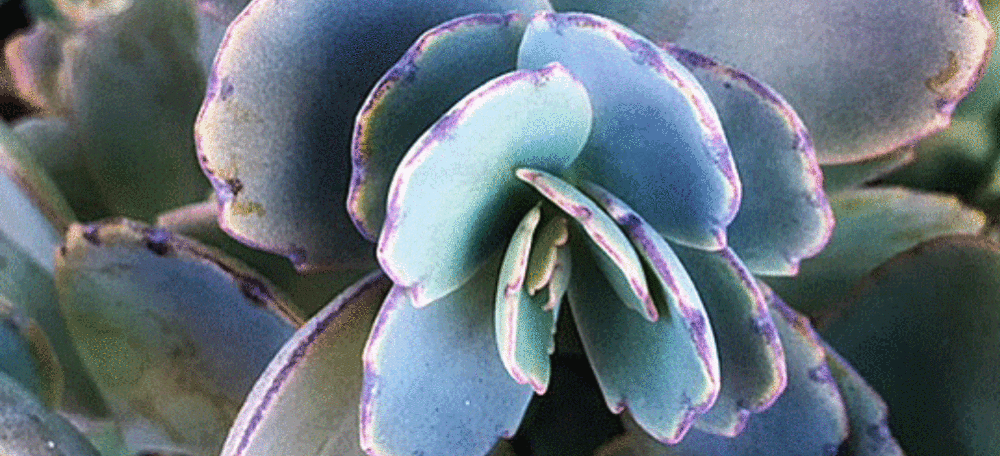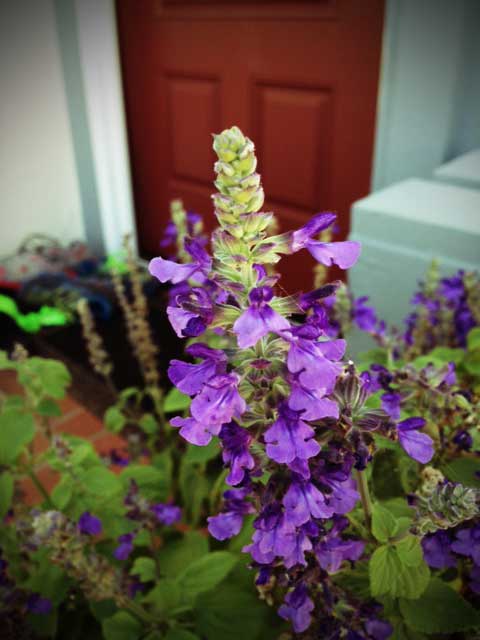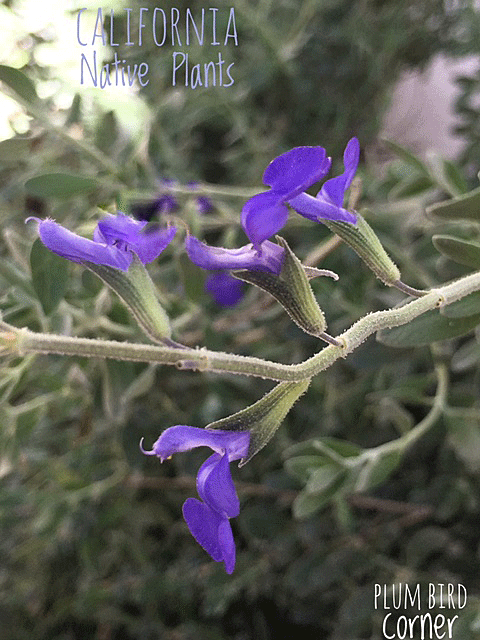
Electric Blue Sage (Salvia chamaedryoides) is a California native plant, and drought tolerant. The small bright blue flowers appear in the spring and continue until fall. The foliage is a peaceful gray-green and the electric blue sage is considered an evergreen perennial. It does well in full sun and partial shade. Mature plants grow 2-3 feet high and are 2-4 feet wide. The Electric Blue Sage is an attractive addition to the garden, year round.
Tag Archives: salvia
Mystic Blue Salvia
In September I wrote about my mandevilla plant that had suffered terribly during an extreme heat wave that occured while we were away on vacation. I’d hoped to be able to return the previously beautiful plant to good health. Unfortunately I wasn’t able to save it, even after careful watering, and relocating it to a less sunny spot in the garden. The direct early morning sun was just too much for it. The plant had looked beautiful near our front door, but now the spot was vacant. I’d recently purchased a Mystic Blue Salvia to add to my hummingbird garden. It was doing well and growing nicely in a large container. I wondered how it would look by the front door in place of the mandevilla. As you can see in the photo above the Mystic Blue is doing very well in its new place and looks even prettier than the mandevilla. It is fuller and fills the area beautifully.
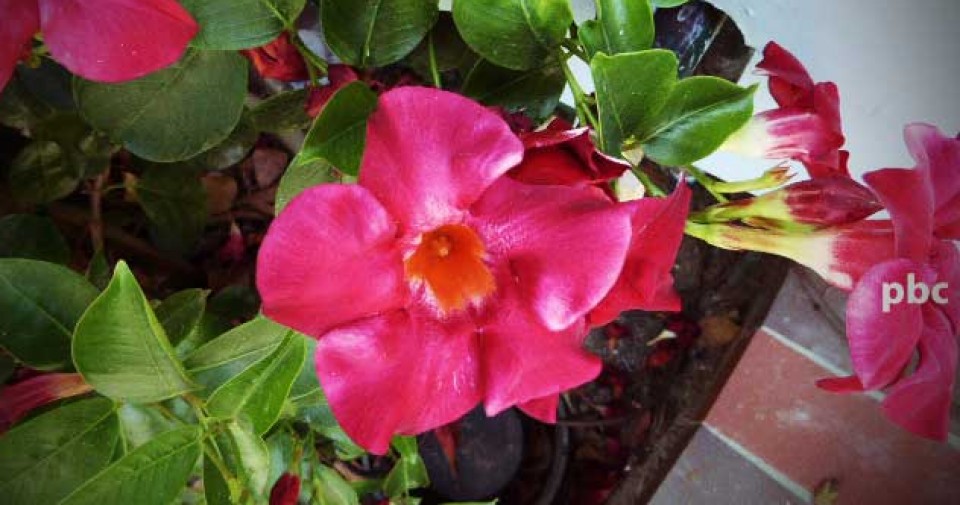 Here you see the mandevilla before our vacation. Both are lovely plants, but the salvia is a better choice for the spot. Most salvia prefer full sun, so will do better in our front garden, especially in the summer. I was very sorry to lose my beautiful pink mandevilla, but I’m very happy with the end result.
Here you see the mandevilla before our vacation. Both are lovely plants, but the salvia is a better choice for the spot. Most salvia prefer full sun, so will do better in our front garden, especially in the summer. I was very sorry to lose my beautiful pink mandevilla, but I’m very happy with the end result.
Garden Calendar
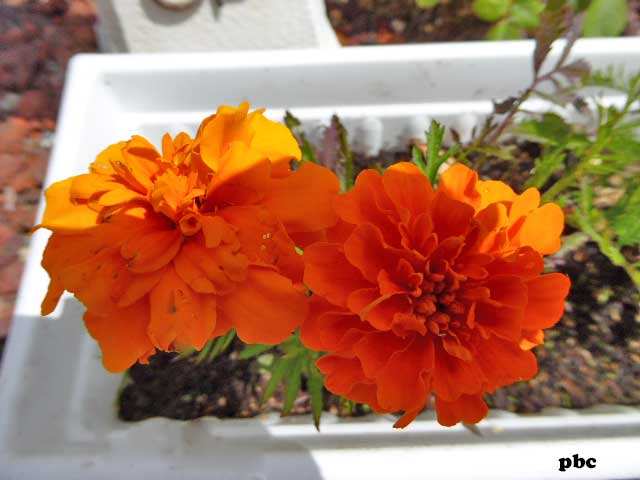 July is nearly half over, so I decided I should be taking a look at my copy of The Twelve Month Gardener’s Journal. I have the West Coast version. Under July I read that I should deadhead annuals and perennials to encourage flowering. With that in mind, I went about the yard with my pruning shears in hand. Above you can see some of the marigolds that brighten up the yard. I love marigolds. They’re so bright and cheery. Our hummingbird garden is doing well, and I recently added another plant to my collection. Below you see two photos of Mystic Spires Blue salvia. I was told that once you start collecting salvia it becomes addicting and it’s true, mainly because they’re available in so many beautiful colors.
July is nearly half over, so I decided I should be taking a look at my copy of The Twelve Month Gardener’s Journal. I have the West Coast version. Under July I read that I should deadhead annuals and perennials to encourage flowering. With that in mind, I went about the yard with my pruning shears in hand. Above you can see some of the marigolds that brighten up the yard. I love marigolds. They’re so bright and cheery. Our hummingbird garden is doing well, and I recently added another plant to my collection. Below you see two photos of Mystic Spires Blue salvia. I was told that once you start collecting salvia it becomes addicting and it’s true, mainly because they’re available in so many beautiful colors.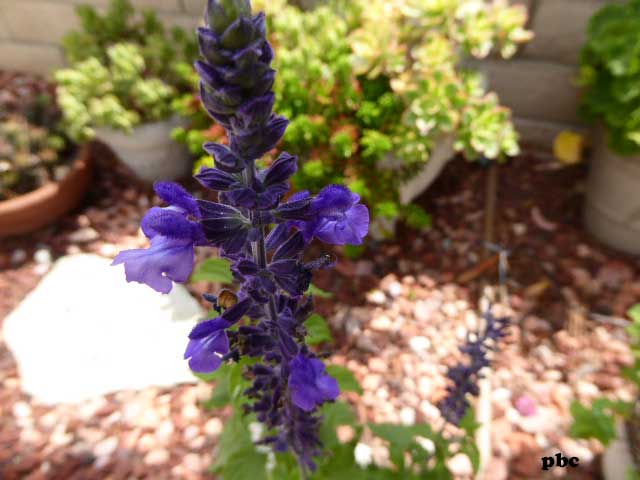
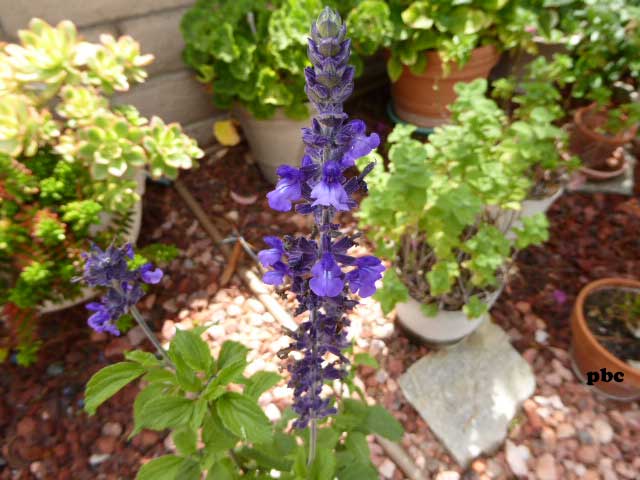
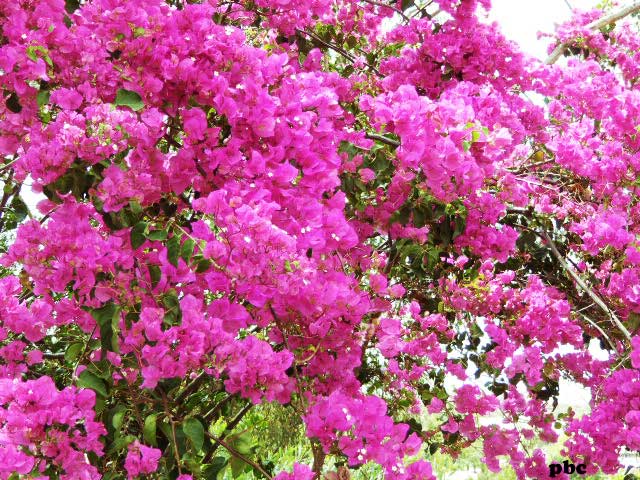
Our Bougainvillea is doing very well this year. This plant was purchased in May of 1977, when I returned to California. This was the first plant I bought, because to me Bougainvillea means California. The plant remained in its original pot until we moved into our new home in November of 77. We first planted it in the front of the house, but it did not do very well there. Later we moved it to the backyard, where it has thrived until this very day. It is the first thing we see each morning when we look out into the garden. I don’t know the life span of a bougainvillea but I do hope we can enjoy its beauty for many more years to come.
Hummingbird Garden Update
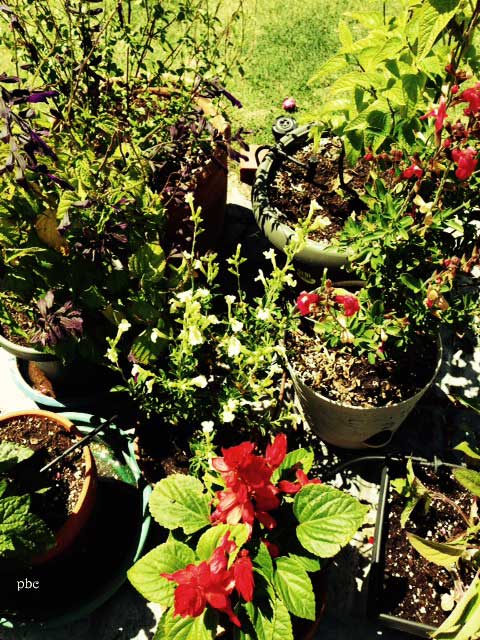 Three weeks ago we started a hummingbird garden. You can read about it in Our Hummingbird Garden and in Our Hummingbird garden Part 2.
Three weeks ago we started a hummingbird garden. You can read about it in Our Hummingbird Garden and in Our Hummingbird garden Part 2.
I’m not sure if readers realized that I potted the plants in containers rather than in the ground. The pots are sitting on flagstone tiles in the center of the yard. It is one of the few places where we get full sun during the day. Most of the sage and salvia plants that attract hummingbirds like a full sun exposure. Each plant has a drip system running to it, but I do have to supplement the water supply. Most of these plants are drought tolerant, but in the hot summer sun, especially in pots, they do need more water.
This morning I went on line to learn how to propagate sage and salvia plants. I discovered a helpful blog called Growing the Home Garden. In a short article I found what I was looking for. I finished reading, and headed into the garden to look for just the right cuttings. As sometimes happens I found myself doing things a little differently than planned, and it also turned out to be a faster way to expand our hummingbird garden.
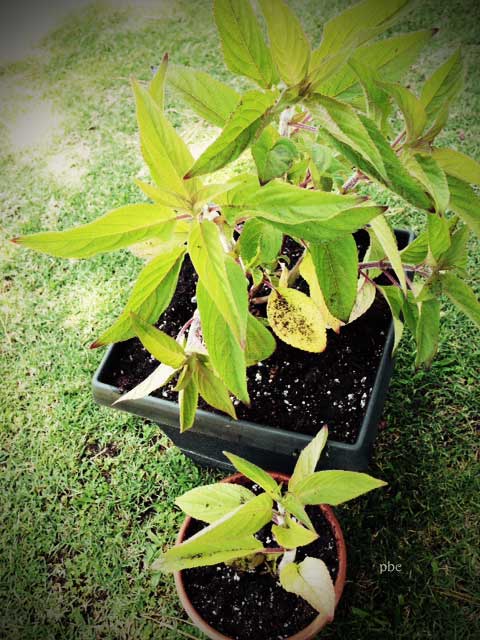 Above is the Pineapple Sage plant, another hummingbird favorite. I purchased a small plant on May 25, and it had already outgrown its original pot. While repotting the sage, I was able to separate a smaller plant that was an offshoot of the larger one. Above you see the original and secondary plants in their new pots. I can’t wait to see their bright red flowers. I will be sure to post a picture when it happens. This plant seems to be a very fast grower, and something tells me I will soon be sharing pineapple sage plants. Pineapple Sage Tea anyone?
Above is the Pineapple Sage plant, another hummingbird favorite. I purchased a small plant on May 25, and it had already outgrown its original pot. While repotting the sage, I was able to separate a smaller plant that was an offshoot of the larger one. Above you see the original and secondary plants in their new pots. I can’t wait to see their bright red flowers. I will be sure to post a picture when it happens. This plant seems to be a very fast grower, and something tells me I will soon be sharing pineapple sage plants. Pineapple Sage Tea anyone?
Our Hummingbird Garden Part 2
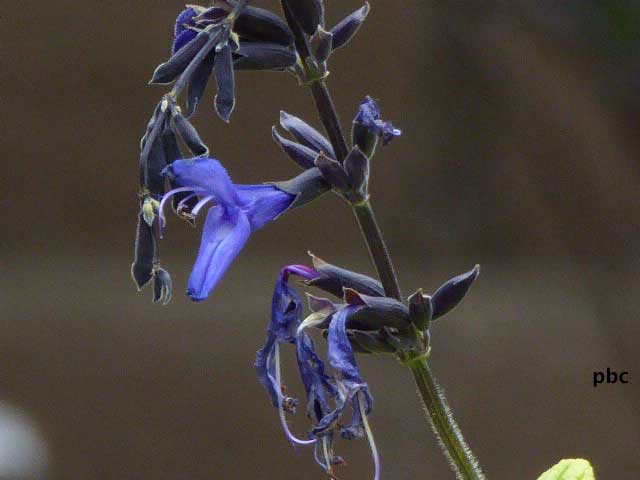 In my previous post, Our Hummingbird Garden, I promised to show you the rest of the plants in our new hummingbird garden. This is Mystic Blue Salvia, although it’s more purple than blue. Again you see the tubular shape to the blossoms, which make them perfect for the hummingbird’s long beak. The plants are doing well, and most are forming new buds.
In my previous post, Our Hummingbird Garden, I promised to show you the rest of the plants in our new hummingbird garden. This is Mystic Blue Salvia, although it’s more purple than blue. Again you see the tubular shape to the blossoms, which make them perfect for the hummingbird’s long beak. The plants are doing well, and most are forming new buds.
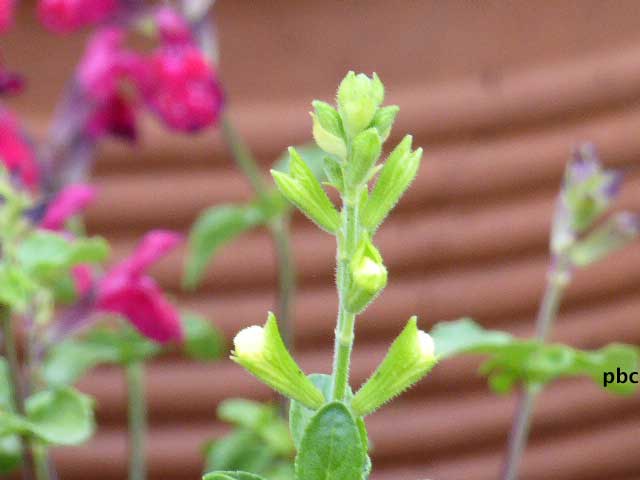 This Lemon Light Salvia is getting ready to flower. We haven’t seen a flowering Lemon Light, and we are really looking forward to the first blossom.
This Lemon Light Salvia is getting ready to flower. We haven’t seen a flowering Lemon Light, and we are really looking forward to the first blossom.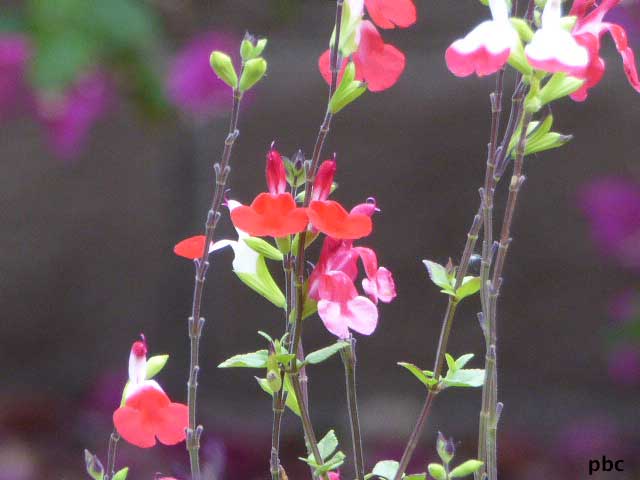 This is Salvia Microphylla, commonly referred to as ‘baby sage’. I love the pink and white heart shaped flowers. This variety is called Hot Lips.
This is Salvia Microphylla, commonly referred to as ‘baby sage’. I love the pink and white heart shaped flowers. This variety is called Hot Lips.
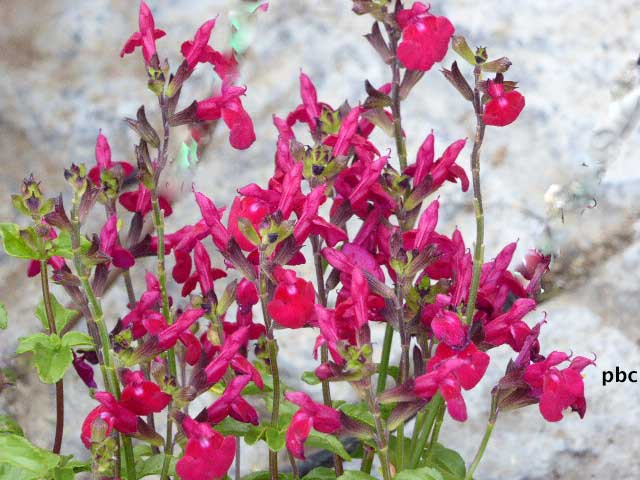 Berkeley Barb is a Mountain Sage. It’s named for a counterculture newspaper that was published in Berkeley California from 1965 to 1980.
Berkeley Barb is a Mountain Sage. It’s named for a counterculture newspaper that was published in Berkeley California from 1965 to 1980.
All of these plants with the exception of Berkeley Barb prefer full sun and are growing happily in the center of our back yard, but we may have to move the little Mountain Sage as the summer progresses and the days become warmer.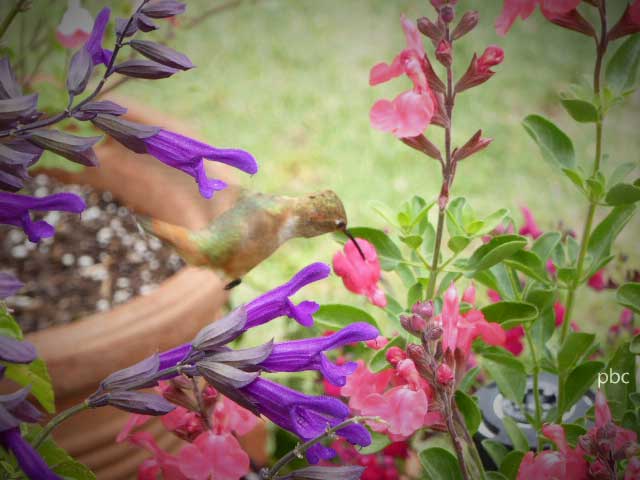 The morning after we started our garden, I was taking long distance photos of the plants, when I realized that a hummingbird was enjoying nectar from the Salvia Gregii. I continued to take photos, hoping I’d caught one of our first visitor. I hope you can see her enjoying some breakfast. As the plants grow and produce more flowers, I’m sure we will see many more of these little birds, and I’ll be posting more and more photographs. I’ll also share any new plants with you as well. I’m sure there will be many more, since there are so many beautiful choices.
The morning after we started our garden, I was taking long distance photos of the plants, when I realized that a hummingbird was enjoying nectar from the Salvia Gregii. I continued to take photos, hoping I’d caught one of our first visitor. I hope you can see her enjoying some breakfast. As the plants grow and produce more flowers, I’m sure we will see many more of these little birds, and I’ll be posting more and more photographs. I’ll also share any new plants with you as well. I’m sure there will be many more, since there are so many beautiful choices.
